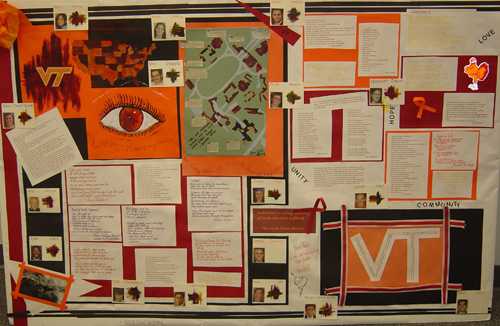| The first thing you notice about the people who are sorting the myriad items sent to Virginia Tech in the wake of April 16 is the care they take in handling each one.
Such as three young men--all college students--helping University Archivist and Digital Librarian Tamara Kennelly move boxes and arrange items into categories. One man apologetically says, "I accidentally dropped my cell phone in this box and wonder if I have your permission to search through it."
"Of course," Kennelly says. She looks down at the box, which is filled with dozens of paper chains signed by grade school children. The messages on the construction paper circles echo those on other memorials and condolences sent from across the country: "We love you. Go Hokies!" There are orange and maroon links as well as blue and green ones, and the box is filled to the top with the chains.
As she helps the young man delicately sift through the top layer, Kennelly says, "I'm touched by how lovingly and respectfully our volunteers have handled these items. They're such emotionally powerful gifts to sort through."
More than 10,000 items will receive this special care. The storage rooms set aside to hold the gifts are divided and labeled by category: handcrafted gifts, signed banners, handwritten letters and cards, and various textiles. "It's an awesome task," says Kennelly.
 |
|
One archive created to preserve and present the stories of April 16 is The April 16 Archive, available at www.april16archive.org. The website includes firsthand observations, photographs, sound recordings, media reports, personal writings, official statements, and blog posts. The website was launched by Virginia Tech's Center for Digital Discourse and Culture in collaboration with George Mason University's Center for History and New Media.
|
|
|
|
|
|
 A display board of the victims with poems, artwork, and letters created by students from North Cross High School in Roanoke, Va. A display board of the victims with poems, artwork, and letters created by students from North Cross High School in Roanoke, Va. |
|
|
|
"Believe it or not, it's possible to get smothered by love," notes Larry Hincker, associate vice president for university relations. "It's a struggle to determine what to save and how to appropriately archive it. We are deeply moved by these heartfelt gestures and physical expressions of sympathy, but we are feeling overwhelmed by the sheer numbers," he adds carefully, avoiding saying outright that the university simply doesn't have the space to accept more items.
Because of the overwhelming support from so many people and institutions from around the world, it will take at least the rest of the summer to tag and sort, digitally photograph, describe, and, finally, select the items that will become part of the Virginia Tech archive related to April 16, 2007. To help with this massive effort, the university plans to hire a team of student workers.
"The Library of Congress came to Blacksburg to consult with us," notes Kennelly. "They recommended that we keep 5 percent of what we have--a representation of everything that was sent in. But I'm not sure how much we'll be able to keep." The issue is not only one of storage space but also the nature of the gifts. For example, some of the paper items were compromised by the weather during the several weeks they were on display on the Drillfield. Other items, such as stuffed animals, food, and care packages, were distributed to students in the weeks following April 16. "Greg Beecher, associate director for administrative and business services for university unions and student activities, did a great job of distributing keepsakes given to the Virginia Tech community," says Kennelly.
Items will be photographed and a digitized record will eventually be made available to the public. This visual record will be part of a larger archive that will include media clips, research compiled by faculty members on such issues as mental health and gun control, and a documentation of the worldwide ripple effect that resulted from the tragedy. "The university is working in cooperation with other organizations on the long-term preservation of materials that illustrate the larger affect April 16 has had on higher education, the local community, and national and international communities," Kennelly says. The physical archive will be housed in University Libraries' Special Collections in Newman Library, and digital images and other components will be made available through the libraries' Web pages.
Archiving such poignant gifts is a challenge most universities never face. Typically, a university archive collects, preserves, and provides access to materials that document the history and development of a university, serving as a research tool. While this collection will become an important part of Virginia Tech's history, it is vastly different from a traditional university archive in both scope and purpose.
"It's been a real learning experience to figure out how to deal with items of this scale, both respectfully and appropriately," says Kennelly. Yet it's also a challenge that university staff members and dozens of volunteers--many of whom are alumni--continue to handle with dignity and respect.
|
The majority of items received by Virginia Tech are condolences and words of support written on paper--posters, banners, letters, and cards. Some of the unique gifts in the collection include a flag flown at half-staff above the Statue of Liberty, a framed inspirational poster sent by the Columbine High School staff, a letterman jacket from the engineering program at the University of British Columbia, a life preserver signed by members of the U.S. Coast Guard, and a letter from President Bush. To see many of the items received, go to www.uusa.vt.edu/artGallery/
virginia_tech_remembers/index.php. |
|

|
 Jennifer Henderson is a writer for University Development. Jennifer Henderson is a writer for University Development.
|

